Understanding the Connection Between Music and Motor Skills

The Basics: What Are Motor Skills?
Motor skills are the abilities required to control bodily movements. These can be classified into two categories: gross motor skills, which involve larger movements like walking or jumping, and fine motor skills, which require more precise actions like writing or buttoning a shirt. Understanding these categories helps us appreciate how different activities, like playing a musical instrument, engage various parts of our motor system.
Music can change the world because it can change people.
For instance, when you learn to ride a bike, you're not just balancing; you're also coordinating your pedaling and steering. This intricate dance of movements illustrates the complexity of motor skills. Each skill is built upon the last, showcasing how interconnected our physical abilities are.
Music, as we'll explore, plays a significant role in developing these skills. Whether it’s the rhythm of a song helping you keep time while dancing or the coordination required to play an instrument, music provides a unique avenue for motor skill enhancement.
The Science Behind Music and Movement
Research shows that music can stimulate brain areas responsible for motor control. When we listen to music, our brains engage in a variety of processes that enhance our ability to move. This can lead to improved coordination and timing, essential components of effective motor skills.

For example, studies have found that children who are exposed to music often show better motor performance than those who are not. This connection highlights how exposure to rhythmic patterns in music can influence the way we move through space, making tasks like dancing or sports more intuitive.
Music Boosts Motor Skills
Engaging with music enhances coordination and timing, making physical activities like dancing and sports more intuitive.
Additionally, the tempo of music can affect our movement speed and rhythm. Upbeat tunes can prompt faster movements, while slower melodies encourage more deliberate actions, showcasing the powerful influence music has on our physical actions.
Music and Motor Skill Development in Children
For children, the connection between music and motor skills can be particularly pronounced. Engaging with music through singing, dancing, or playing instruments can significantly enhance their physical abilities. Activities like these not only make learning fun but also embed essential skills in a playful manner.
Dance is the hidden language of the soul.
For instance, clapping to a beat or following dance moves requires children to use both their listening and motor skills simultaneously. This dual engagement fosters a deeper understanding of coordination and rhythm. Over time, these experiences can lead to improved dexterity and overall motor function.
Moreover, music education has been linked to better outcomes in physical education and sports. Children who participate in music-related activities often exhibit greater agility and control in physical tasks, demonstrating how interwoven these disciplines can be.
The Role of Rhythm in Motor Coordination
Rhythm is a crucial element when it comes to developing motor skills. It serves as a guide, helping us synchronize our movements. When we dance or play an instrument, we rely on rhythm to time our actions, leading to improved coordination and timing.
For example, drumming involves not just striking the drum but also maintaining a steady beat. This repetitive motion trains our bodies to anticipate and respond to rhythmic cues, reinforcing our motor pathways. The more we practice, the more automatic these skills become.
Rhythm Guides Movement
Rhythm serves as a crucial guide for synchronizing movements, improving motor coordination through practices like dancing and drumming.
Additionally, rhythm can be therapeutic. Music therapy often uses rhythmic exercises to help individuals with motor impairments regain movement. This approach underscores the power of rhythm as a tool for enhancing both physical coordination and emotional well-being.
Playing Instruments: A Hands-On Approach to Skill Building
Playing an instrument is one of the most effective ways to develop fine motor skills. Each instrument requires specific finger movements and hand-eye coordination, leading to enhanced dexterity over time. For instance, piano players must learn to coordinate both hands independently, a skill that translates to other activities requiring precision.
Moreover, the act of reading music further challenges musicians. Interpreting notes while executing movements requires multitasking, which strengthens cognitive and motor connections. This complexity not only makes playing an instrument rewarding but also significantly boosts overall motor skill development.
The benefits aren't limited to just musicians. Even those who engage in simple music-making activities, like tapping feet or clapping, can experience improvements in their motor skills. It’s a perfect illustration of how accessible music can be for everyone.
Music, Exercise, and Motor Skills: A Perfect Pair
Combining music and exercise is a powerful way to enhance motor skills. Many fitness classes incorporate music to keep participants motivated and in rhythm, which can lead to improved coordination. Activities like Zumba or aerobics rely heavily on music to guide movements, making the experience both enjoyable and effective.
Studies have shown that exercising with music can improve timing and accuracy in physical tasks. When participants synchronize their movements to a beat, they often perform better than those who exercise in silence. This finding underscores the importance of music in enhancing physical performance.
Instruments Improve Dexterity
Playing musical instruments enhances fine motor skills and hand-eye coordination, benefiting overall physical abilities.
Incorporating music into exercise routines not only boosts motor skills but also elevates the overall experience. The enjoyment factor encourages regular participation, leading to a win-win situation for physical health and skill development.
Conclusion: Embracing the Music-Motor Skill Connection
The connection between music and motor skills is both fascinating and beneficial. From enhancing children's coordination to improving fitness routines, music serves as a catalyst for physical development. Embracing music in our daily lives can unlock new avenues for growth and enjoyment.
Whether you’re dancing in your living room or playing a musical instrument, remember that you’re also honing your motor skills. This engagement enriches our physical experiences and fosters a deeper appreciation for the rhythm of life.

So next time you hear your favorite song, take a moment to notice how it moves you—both physically and emotionally. By understanding and leveraging this connection, we can enhance our lives in delightful and unexpected ways.